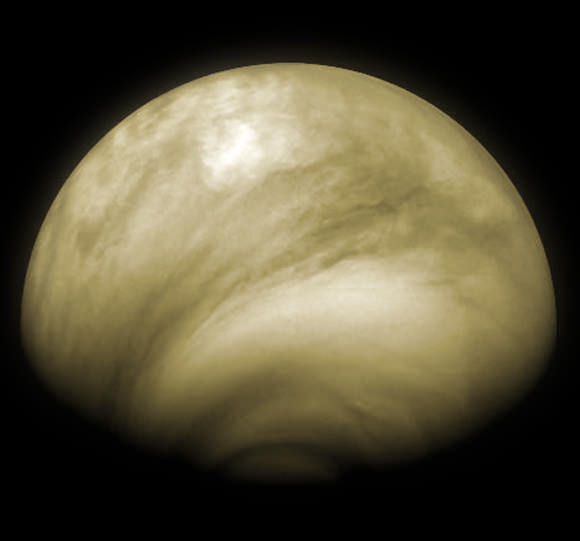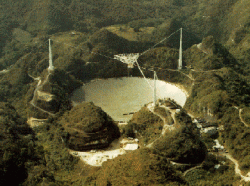[/caption]
You may have heard in your wanderings through the blogosphere and in the internet today that NASA will be holding a press conference on December 2nd in which they will make an announcement regarding information the search for extraterrestrial life. And that this announcement involves astrobiology, the study of life outside what we know about here on Earth. While true, it is nothing to get worked up about.
Speculation abounds that this is, “the big one,” and that an announcement will be made that extraterrestrial life has been discovered. You can find this speculation at Kottke.org, io9, Gawker, and a lot of other places.
To be clear, there is almost no chance that the press release will be announcing little green men or little brown bacteria anywhere. Follow along for the long explanation below the fold.
Here’s what the press release is titled: “NASA Sets News Conference on Astrobiology Discovery: Science Journal Has Embargoed Details Until 2 p.m. EST On Dec. 2”. All this means is that Science Journal will be publishing some results related to astrobiology that are under embargo until that time. The embargo system is a basically a way of allowing journalists to see scientific results and get interviews and do research on an article before it’s published, but only if they promise to publish their information after the original publication does so. It makes sense, and it works most of the time to the benefit of almost everyone.
NASA regularly – like every day – announces upcoming press conferences and releases, and embargoed press releases float around to science writers like those of us here at Universe Today. This in itself is nothing out of the ordinary, and anyone with an email address can sign up to have these announcements delivered to their inbox or view them on NASA’s website. These emails are meant mainly to notify members of the press that there is something coming up worthy of being a phone-in listener of, the details of which require you to have press credentials.
The press release goes on to say,
“NASA will hold a news conference at 2 p.m. EST on Thursday, Dec. 2, to discuss an astrobiology finding that will impact the search for evidence of extraterrestrial life. Astrobiology is the study of the origin, evolution, distribution and future of life in the universe.
The news conference will be held at the NASA Headquarters auditorium at 300 E St. SW, in Washington. It will be broadcast live on NASA Television and streamed on the agency’s website at http://www.nasa.gov.
Participants are:
– Mary Voytek, director, Astrobiology Program, NASA Headquarters, Washington
– Felisa Wolfe-Simon, NASA astrobiology research fellow, U.S. Geological Survey, Menlo Park, Calif.
– Pamela Conrad, astrobiologist, NASA’s Goddard Space Flight Center, Greenbelt, Md.
– Steven Benner, distinguished fellow, Foundation for Applied Molecular Evolution, Gainesville, Fla.
– James Elser, professor, Arizona State University, Tempe”
And that’s about it. My first reaction to this was that they had potentially made the discovery of exotic, new organic molecules in an exoplanetary atmosphere, or that some chemical conducive to the existence of life as we know it was possibly found on some body in the Solar System. Announcements like this come out of NASA all of the time.
Just because some of the participants do work in fields that are related to oceanography or ecology or biology, does not mean that their services are required here to help make an announcement that life other than that on Earth has been discovered, as other speculative bloggers might think.
As Nancy wrote in a post earlier today, extraterrestrial life is very much of interest to Universe Today readers. Which is why she’ll be listening in on that news conference Thursday, and reporting what findings are released.
Extraterrestrial life is very much of interest to probably most of the population of our planet, too, and the fact that we have the tools necessary to potentially make this discovery within the next few hundred years (or sooner), is really, really exciting.
But just because it’s exciting doesn’t mean we have to jump all over a NASA press release that includes the words “extraterrestrial life” or “precursor to life on Mars” and make wild speculations. When that announcement is made (or if, depending on how you choose to solve the Drake Equation), you can be sure that it will be very closely guarded until being made public, and after that the President will likely have some things to say.
For some more level-headed analysis, Keith Cowing at Nasa Watch has some much more reasonable speculation that the announcement involves arsenic biochemistry. The Bad Astronomer, Phil Plait, also has a good debunking of the rampant speculation, and makes some good points about how NASA can create press releases in the future that have better-worded announcements.
So calm down – but don’t stop looking up! Keep being excited about all of the genuinely cool and exciting developments we’re currently making with regards to space.
Source: NASA press release




